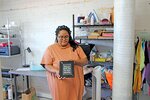By Talia McWright
Arnée Martin wanted 100 rejections.
“The worst they can say is no,” Martin said.
As an artist applying for grants and scholarships, the TikTok trend of getting rejected 100 times inspired Martin to attempt just that. What they didn’t expect was that they’d be selected for the Springboard for the Arts (262 University Ave. W.) Guaranteed Artist Income program without even applying.
Wone Vang
Wone Vang has been the economic opportunity director at Springboard for the Arts since September of 2022. She, like all of the staff at Springboard, is an artist. Vang and her sister, Youa, own a nontraditional cross stitching business called, “Third Daughter, Restless Daughter.” Growing up, the sisters would do traditional Hmong cross stitching, “Paj Ntaub,” with their mother and grandmother. The two have put their own twist on the traditional art, by including humor and pop culture references in their work.
In her role as the economic opportunity director, Vang builds relationships and creates partnerships with other businesses and organizations to support artists. Her team works on connecting local artists to resources, professional development programming and more.
In 2021, Springboard created an emergency relief fund that provided $500 a month to artists who’d lost commission due to COVID-19. Twenty-five artists from the Rondo and Frogtown neighborhoods were supported through the emergency relief fund, which then inspired the Guaranteed Artist Income (GAI) program.
Through GAI, artists receive $500 a month for 18 months, free of requirements. In total there are 75 GAI artists, 25 in Springboard’s Fergus Falls location (201 W. Lincoln Ave.) and 50 in the Rondo/Frogtown location, 25 of whom rolled over from the initial emergency relief fund. In 2023, Springboard is in its second phase of GAI.
“We wanted to make it as easy as possible for individuals so they did not have to go through so many steps to be a part of this program,” Vang said.
Vang expressed that the $500 monthly amount does not replace a social safety net, but supplements the artist’s income. The program is in its second year, and there are plans to add more components to the program. After the first year, Springboard staff noticed that there was a need for artists to be connected to more resources and support. Vang has been working to build relationships with home ownership organizations, studio spaces and financial planning.
“We want to make sure that we have the right partnerships and connections so we can give them [the artists] information and they have individuals to reach out to as needed,” Vang said.
Vang said that before working at Springboard, she worked a full-time job on top of connecting with other artists and running her cross stitching business. Springboard has allowed her to work a full-time job, in which she partners with artists, and can continue to cross stitch. Vang enjoys working with artists, and brainstorming on initiatives to enhance and improve their communities.
“I’ve always loved working with other artists and collaborating,” Vang said.
The money given to GAI program recipients is meant to be used how they see fit – whether it is to purchase art equipment, buy groceries or go towards rent. Vang said that some artists share how they used part of the money they received to do a fun activity, like watch a movie, but weren’t sure if that was okay.
“It’s up to them,” Vang said. “In the end it’s about their mental wellbeing because that’s going to help them create, and they don’t have to worry about other things that might be impacting what they do.”
Ricardo Beaird
Uptown resident Ricardo Beaird is a devised theater artist, and started his role as the community development director at Springboard in 2021. Beaird works with artists to help address community needs. Beaird facilitates the narrative change component, partnering with artists in sharing their stories of the impact of the program on them and their families. Through narrative change, a cohort of five commissioned artists called, “Artist’s Respond: People Place and Prosperity,” emerged. A second cohort of four artists from St. Paul, and four artists from Otter Tail County will be launched in 2023.
“This cohort learns together,” Beaird said. “They learn about what narrative change is. They learn about the state of guaranteed income locally in Frogtown and Rondo, and what the national movement looks like. From there they’re inspired to create public projects, and we help them do that.”
Beaird said that being an artist is a lot of trial and error, sometimes at the expense of oneself, causing cycles of burnout. He thinks Springboard is special as it is a home and hub for artists to gather and share knowledge, wisdom and their personal pathways of navigating trial and error. He expressed that it feels good to know that there’s an organization that looks out for Twin Cities artists locally, and shares their stories and work nationally.
“As someone who works within artist communities, I think that because artists are receiving the support and safety net, they’re able to experiment in ways they weren’t able to before,” Beaird said.
Beaird explained that many have the mindset that poverty is the fault of the impoverished. He hopes that programs like GAI will become normalized and reshape people’s perception of deservedness. He expressed that if people can get on board with these kinds of ideas and programs, there could be a systemic shift that will benefit everyone.
Kalyn Flynn
Kalyn Flynn of Philadelphia started working at Springboard in 2021 during the launch of the GAI program. Flynn is a qualitative data scientist at the Center for Guaranteed Income Research at the University of Pennsylvania. She uses critical ethnography to collect information on the artist’s experience with the GAI program at Springboard. Flynn travels to St. Paul once a quarter to build relationships with the artists and gather research.
“I count them each [artists] as extended friends and family,” Flynn said.
Flynn expressed that because of the qualitative research she conducts on the artists, she is able to directly see the impact of the GAI program on their lives. She said that when artists are not full-time, it can cause the person to doubt that they are an artist. She feels that the GAI program makes these artists feel seen in their work.
“I think it is incredibly powerful for people to receive guaranteed income on the sole basis that they are an artist,” Flynn said. “It’s a validation of an identity.”
Some of the ways Flynn has seen the program impact artists is in home security. She’s witnessed the program help people save to buy a home, and remain in communities that are important to them. Flynn said one artist told her that “financial stress is the ruler of all other stress,” and the GAI program helps relieve people of this burden. She’s seen it help people get out of debt, travel and connect with other artists, and create art for their community to consume.
“This allows artists to create what’s important for them, to not feel like their trauma is constantly being minded by others,” Flynn said, “and to create work that is meaningful that they want to share within their communities in different ways.”
Flynn explained that art is not only for the artist, but for the consumers, as well. She thinks that the work of these artists can inspire others to be artists. She said that guaranteed income acknowledges the agency of the artists, by affirming that they know best what to do with their money.
“I truly believe that art is central to our humanity, and I think it’s overlooked because people don’t see all of the labor that goes into the creation of a piece of art,” Flynn said.
Arnée Martin
Martin is an art elementary school teacher with St. Paul public schools, and a recipient of the Springboard GAI program. She is a multidisciplinary artist, focusing currently on cross stitching. Martin is originally from Charleston, S.C., and moved in part to Minnesota in 2018 because the state has allowed them to better balance their work as a teacher with their work as an artist. Martin is non binary and uses she/ they pronouns interchangeably.
“I’m a good art teacher because I’m an artist, and I’m a good artist because I’m a teacher,” Martin said. “They work in tandem.”
Besides drawing, cross stitching was the first art form Martin did. She also does photography, makes stickers and does printmaking. Martin wants to create art that is financially accessible, and printmaking allows her to do so. They share their art in galleries, like one they were involved in over the summer called “Embodied Material” at Fresheye Gallery in Minneapolis (4238 Nicollet Ave.). The gallery displayed work of their cross stitching, representing their queer and Black identity.
Martin took a class at Springboard called, “Selling Your Art,” which is how they got introduced to the organization. Through receiving guaranteed income through Springboard, Martin has gained more confidence to pursue their artistry. At one point in their life, Martin’s bedroom was also her studio. She was juggling paying rent and creating art in a small space. The program has alleviated stress, allowing her to pay her rent without fear. She has also been able to push herself to do art in new ways, like creating mass installments of her cross stitching. They also now have a studio in the Northrup King Building (1500 Jackson St. NE, Minneapolis) with PF Studios.
“It’s just allowed me to be a practitioner of my art,” Martin said.
Martin said that as a non-Minnesota native, she feels she has some privilege as a Black person living in the state. They want to acknowledge that being able to move to Minnesota is an experience of privilege. She grew up in a two-parent household with military and government background, and expressed that in Minnesota many Black and Brown people are disenfranchised, and she wants to be aware of her privileges.
“If it’s been this helpful to me as a person who’s already having these privileges, I can’t even imagine how it’s been helpful for someone who grew up in this state that is not friendly,” Martin said. “They’re Minnesota nice to Black and Brown people, which I’ve learned is just downright a lack of communication.”
Martin expressed that as a Black, queer artist, their art is for everyone, but does not tailor towards a White audience. Minnesota has been a culture shock for them, and said they’ve seen White people have disgusted facial expressions while looking at Martin’s work. She’s created pieces with sayings like, “Okay colonizer,” and “Okay gentrifier.” Martin creates art that highlights these parts of their identity. She also has Indigenous roots, and is exploring how to express this in her work. They use humor in their work as well, which can get their messages across in a playful way.
“If I have to look at it for multiple days, I want to enjoy it,” Martin said.
Martin described their art as a way to live more authentically. She processes information and experiences through her art, and imagines that it will be ever changing. Having the space, finances, and time in her schedule has allowed Martin to keep going with their art, and GAI has helped her to do so and be excited about her work.


Comments
No comments on this item Please log in to comment by clicking here